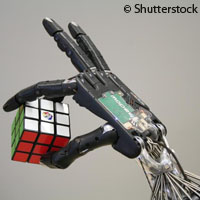Robotic hand made more natural
Understanding the intricacies of how the human hand functions is an essential part of developing an artificial, anthropomorphic articulated hand, and an EU-funded project that aims to do just that is well under way. HANDLE, which brings together researchers from 9 partner institutions across 6 European countries, received a EUR 6.35 million boost under the 'Information and communication technologies' (ICT) Theme of the Seventh European Framework Programme (FP7). The pan-European research team, hailing from Germany, Spain, France, Portugal, Sweden and the United Kingdom, hope to develop a more autonomous artificial hand that can make natural movements. The robotic hand the researchers are developing is the same size as an average adult male's hand and weighs around 4 kg. It is made up of numerous high-precision pieces of mechanised aluminium and plastic, as well as sensor and movement systems. In all, it has 20 actuators and can make 24 movements - the same number of movements a human hand can make. 'In addition to the desired technological advances, we are working with basic aspects of multidisciplinary research in order to give the robotic hand-system advanced perception capabilities, high-level information control and elements of intelligence that would allow it to recognise objects and the context of actions,' explains Mohamed Abderrahim, one of the project researchers from Madrid University's Department of Systems Engineering and Automation in Spain. So far, the Spanish team report successful results in the areas of visual perception, and cinematic and dynamic systems: the system can recognise an object in its surroundings and pass the information on to the robotic hand's planning and movement system. However, developing a robotic hand is not all plain sailing. When trying to recreate the movements of a human hand with a robotic system, there are several stumbling blocks, most notably a lack of space within the hand. 'A human hand is incredibly complete, which makes it a challenge to try to put all of the necessary pieces into the robotic hand and to integrate all of the actuators that allow for mobility similar to that of a human hand,' comments Professor Mohamed Abderrahim. Another problem is that there are currently no sensors on the market that are small enough to be integrated into the device so that it can have sensitivity similar to that of a human hand and in turn make precise movements. Although the researchers may manage to make a perfect robot from the mechanical and sensorial points of view, without intelligence elements the device will not be able to function autonomously, nor adapt its movements and controls to the characteristics of objects, such as their geometry, texture, weight or use. For example, there is a difference between taking hold of a screwdriver to pass it to someone, or putting it away, and using it: the latter action requires the screwdriver to be reoriented in the hand until it is in the right position to be used, and it is the intelligence part of the hand that controls these movements. The researchers underline that - as yet - a robotic hand which can perform simple tasks autonomously only exists in science fiction films. 'My personal estimation is that it will take around 15 years of research into these areas to build a robotic hand that is able to perform certain complex tasks with a level of precision, autonomy and dexterity that is similar to that of a human hand,' states Professor Abderrahim. The next phase of the HANDLE project, which runs until 2013, will be to integrate all the results obtained by the nine project partners into one single system.For more information, please visit: Universidad Carlos III de Madrid: http://www.uc3m.es/portal/page/portal/inicio HANDLE: http://www.handle-project.eu/
Countries
Germany, Spain, France, Portugal, Sweden, United Kingdom



